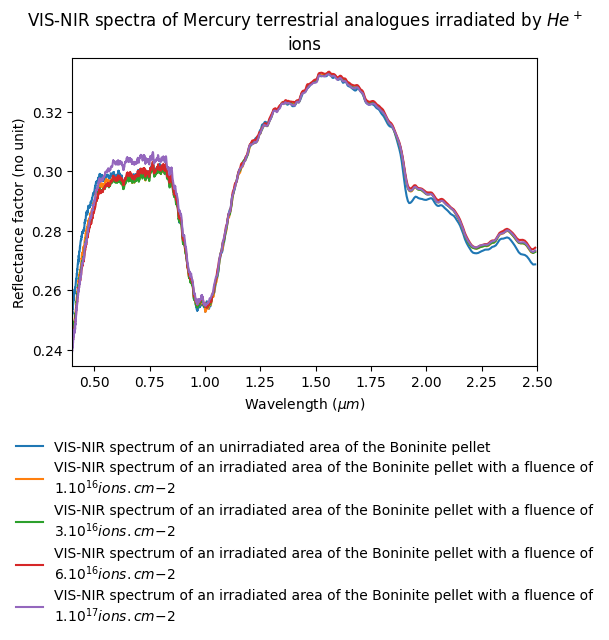- DOI
- 10.26302/SSHADE/EXPERIMENT_ZED_20250131_01
- Data reference
- Caminiti, Emma; Lantz, Cateline (2024): VIS-NIR spectra of Mercury terrestrial analogues irradiated by $He^+$ ions. SSHADE/DAYSY (OSUG Data Center). Dataset/Spectral Data. https://doi.org/10.26302/SSHADE/EXPERIMENT_ZED_20250131_01
- Database(s)
- Experimentalists
- Type(s)
- laboratory measurement
- Description
- VIS-NIR spectra of Mercury terrestrial analogues pellets: unirradiated area and area irradiated by $He^+$ ions at 20 keV and a fluence up to $5.10^{17} ions.cm{-2}$.
- Number of spectra
- 25
- Variable type(s)
-
- sample composition
- irradiation dose
- Comments
- We irradiated pellets of Mercury terrestrial analogues on the SIDONIE isotope separator at IJCLab (Orsay, France) using $He^+$ ions at 20 keV and a fluence up to $5.10^{17}$ $ions.cm^{-2}$ .Two pellets were measured for each type of analogues. For each pellet, half of the samples was measured unirradiated and the other half was measured after irration with He+ with a fluence of $1.10^{17}$ $ions.cm^{-2}$ for the first samples and $5.10^{17}$ $ions.cm^{-2}$ for the second sample (bis).
- Laboratory
- Institut d'Astrophysique Spatiale (IAS)
- Standard medium
- vacuum
- Observation mode
- spectrum
- Spectral range type(s)
- Vis
- Valid spectral range(s)
-
Min - Max (${\mu}m$) Sampling (${\mu}m$) Resolution (${\mu}m$) Position accuracy (${\mu}m$) Absorption edge #1 0.4 - 1.05 0.0005 1.0
Definition: incidence and emergence angles are positive with origin at nadir, and vary in same direction. Azimuth origin (increasing clockwise) is for i = e (opposition geometry).
- Observation geometry
- bidirectional
- Observation mode
- fixed angles
- Incidence angle
- 15.0°
- Emergence angle
- 15.0°
- Azimuth angle
- 0.0°
- Phase angle
- 20.0°
- Observation mode
- single spot
- Comments
- Collection spot size of 3-4 mm in diameter
- Instrument
- Bruker Tensor - reflection Near-IR
- Standard medium
- vacuum
- Observation mode
- spectrum
- Spectral range type(s)
- NIR
- Valid spectral range(s)
-
Min - Max (${\mu}m$) Sampling (${\mu}m$) Resolution (${\mu}m$) Position accuracy (${\mu}m$) Absorption edge #1 0.9 - 2.5 0.0005 1.0
Definition: incidence and emergence angles are positive with origin at nadir, and vary in same direction. Azimuth origin (increasing clockwise) is for i = e (opposition geometry).
- Observation geometry
- bidirectional
- Observation mode
- fixed angles
- Incidence angle
- 20.0°
- Emergence angle
- 15.0°
- Azimuth angle
- 0.0°
- Phase angle
- 15.0°
- Observation mode
- single spot
- Comments
- Collection spot size of 3-4 mm in diameter
- Date begin
- 2024-01-01
Versions
- Release date
- 2025-02-17 11:26:22+0000 UTC
- Version (Date)
- #1 (2025-02-17 11:26:22+0000 UTC, Updated: 2025-02-17 11:26:22+0000 UTC)
